Chevrolet Trax 2019 Owner's Manual
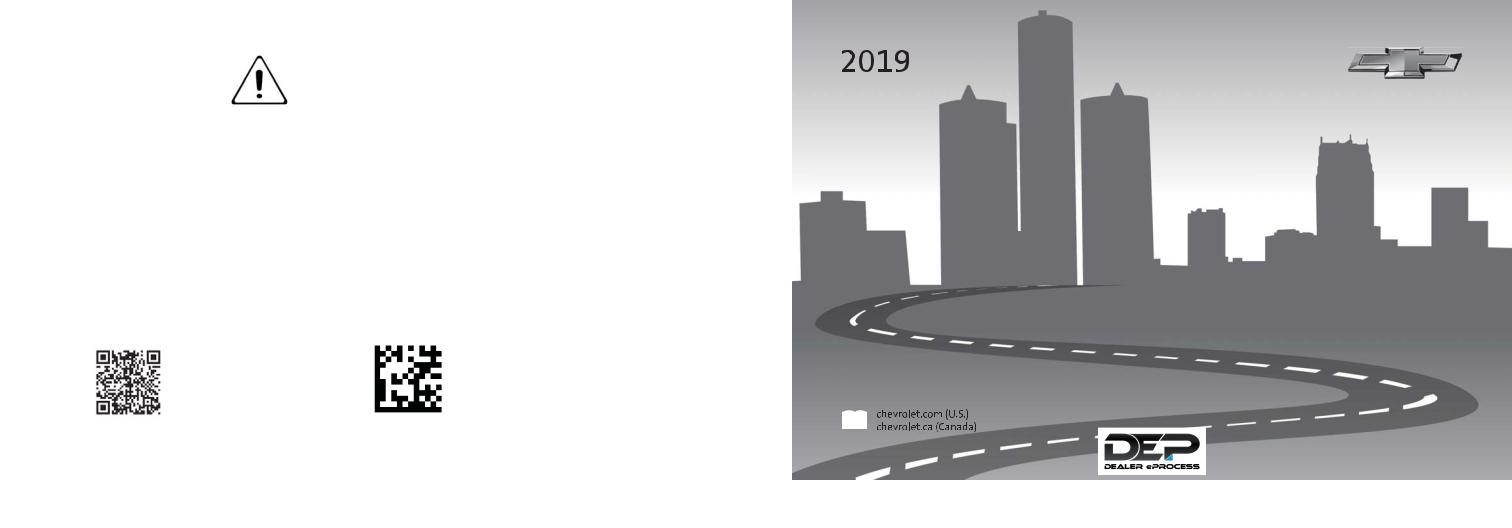
TRAX
Owner’s Manual

Contents
Introduction . . . . . . . . . . . . . . . . . . . . . . 2
In Brief . . . . . . . . . . . . . . . . . . . . . . . . . . . 5
Keys, Doors, and Windows . . . . . 27
Seats and Restraints . . . . . . . . . . . 54
Storage . . . . . . . . . . . . . . . . . . . . . . . 104
Instruments and Controls . . . . . . 107
Lighting . . . . . . . . . . . . . . . . . . . . . . . 138
Infotainment System . . . . . . . . . . 145
Climate Controls . . . . . . . . . . . . . . 171
Driving and Operating . . . . . . . . . 176
Vehicle Care . . . . . . . . . . . . . . . . . . 228
Service and Maintenance . . . . . 315
Technical Data . . . . . . . . . . . . . . . . 330
Customer Information . . . . . . . . . 334
Reporting Safety Defects . . . . . . 345
OnStar . . . . . . . . . . . . . . . . . . . . . . . . 348
Connected Services . . . . . . . . . . . 356
Index . . . . . . . . . . . . . . . . . . . . 360

2Introduction
Introduction
The names, logos, emblems, slogans, vehicle model names, and vehicle body designs appearing in this manual including, but not limited to, GM, the GM logo, CHEVROLET, the CHEVROLET Emblem, and TRAX are trademarks and/or service marks of General Motors LLC, its subsidiaries, affiliates,
or licensors.
For vehicles first sold in Canada, substitute the name “General Motors of Canada Company” for Chevrolet Motor Division wherever it appears in this manual.
This manual describes features that may or may not be on the vehicle because of optional equipment that was not purchased on the vehicle, model variants, country specifications, features/applications that may not be available in your region, or changes subsequent to the printing of this owner’s manual.
Refer to the purchase documentation relating to your specific vehicle to confirm the features.
Keep this manual in the vehicle for quick reference.
Canadian Vehicle Owners
A French language manual can be obtained from your dealer, at www.helminc.com, or from:
Propriétaires Canadiens
On peut obtenir un exemplaire de ce guide en français auprès du concessionnaire ou à l'adresse suivante:
Helm, Incorporated
Attention: Customer Service
47911 Halyard Drive
Plymouth, MI 48170
USA
Using this Manual
To quickly locate information about the vehicle, use the Index in the back of the manual. It is an alphabetical list of what is in the manual and the page number where it can be found.
Litho in U.S.A. |
|
Part No. 84180410 A First Printing |
2018 General Motors LLC. All Rights Reserved. |
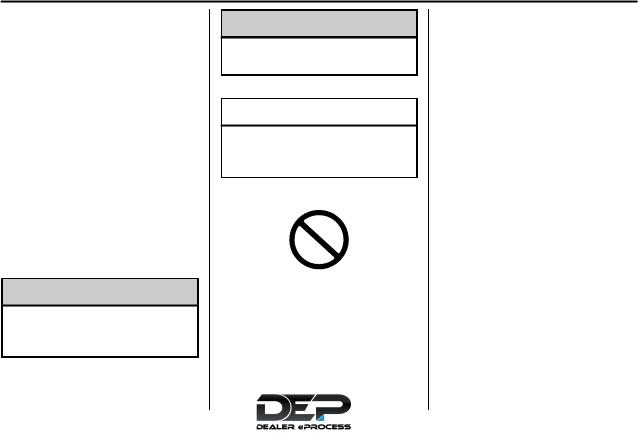
Introduction 3
About Driving the Vehicle
As with other vehicles of this type, failure to operate this vehicle correctly may result in loss of control or a crash. Be sure to read the driving guidelines in this manual in the section called “Driving and Operating” and specifically Driver Behavior 0 177, Driving Environment 0 177, and Vehicle Design 0 177.
Danger, Warning, and
Caution
Warning messages found on vehicle labels and in this manual describe hazards and what to do to avoid or reduce them.
{Danger
Danger indicates a hazard with a high level of risk which will result in serious injury or death.
{Warning
Warning indicates a hazard that could result in injury or death.
Caution
Caution indicates a hazard that could result in property or vehicle damage.
A circle with a slash through it is a safety symbol which means “Do Not,” “Do not do this,” or “Do not let this happen.”
Symbols
The vehicle has components and labels that use symbols instead of text. Symbols are shown along with the text describing the operation or information relating to a specific component, control, message, gauge, or indicator.
M : Shown when the owner’s manual has additional instructions or information.
* : Shown when the service manual has additional instructions or information.
0 : Shown when there is more information on another page — “see page.”

4Introduction
Vehicle Symbol Chart
Here are some additional symbols that may be found on the vehicle and what they mean. See the features in this manual for information.
u : Air Conditioning System
G : Air Conditioning Refrigerant Oil
9 : Airbag Readiness Light
! : Antilock Brake System (ABS) $ : Brake System Warning Light
9: Dispose of Used Components Properly
B : Engine Coolant Temperature
_ : Flame/Fire Prohibited
H : Flammable
[: Forward Collision Alert
+ : Fuses
j : ISOFIX/LATCH System Child Restraints
|: Lane Change Alert
@ : Lane Departure Warning
A : Lane Keep Assist
* : Malfunction Indicator Lamp
: : Oil Pressure
X: Park Assist
~ : Pedestrian Ahead Indicator
O : Power
7: Rear Cross Traffic Alert
I : Registered Technician
/ : Remote Vehicle Start
> : Seat Belt Reminders
I : Side Blind Zone Alert
h : Start/Stop
7 : Tire Pressure Monitor
d : StabiliTrak/Electronic Stability
Control (ESC)
a : Under Pressure
V: Vehicle Ahead Indicator

In Brief |
5 |
In Brief
Instrument Panel
Instrument Panel . . . . . . . . . . . . . . . . 6
Initial Drive Information
Initial Drive Information . . . . . . . . . . 8
Remote Keyless Entry (RKE)
System . . . . . . . . . . . . . . . . . . . . . . . . 8
Remote Vehicle Start . . . . . . . . . . . 9
Door Locks . . . . . . . . . . . . . . . . . . . . . 9
Liftgate . . . . . . . . . . . . . . . . . . . . . . . . 10
Windows . . . . . . . . . . . . . . . . . . . . . . . 10
Seat Adjustment . . . . . . . . . . . . . . . 11
Second Row Seats . . . . . . . . . . . . 12
Heated Seats . . . . . . . . . . . . . . . . . . 12
Head Restraint Adjustment . . . . 12
Seat Belts . . . . . . . . . . . . . . . . . . . . . 13
Passenger Sensing System . . . 13
Mirror Adjustment . . . . . . . . . . . . . . 13
Steering Wheel Adjustment . . . . 14
Interior Lighting . . . . . . . . . . . . . . . . 14
Exterior Lighting . . . . . . . . . . . . . . . 15
Windshield Wiper/Washer . . . . . . 16
Climate Controls . . . . . . . . . . . . . . . 16
Transmission . . . . . . . . . . . . . . . . . . 17
Vehicle Features
Infotainment System . . . . . . . . . . . 18
Radio(s) . . . . . . . . . . . . . . . . . . . . . . . 19
Satellite Radio . . . . . . . . . . . . . . . . . 19
Portable Audio Devices . . . . . . . . 19
Bluetooth . . . . . . . . . . . . . . . . . . . . . . 20
Steering Wheel Controls . . . . . . . 20
Cruise Control . . . . . . . . . . . . . . . . . 21
Driver Information
Center (DIC) . . . . . . . . . . . . . . . . . 21
Forward Collision Alert (FCA)
System . . . . . . . . . . . . . . . . . . . . . . . 21
Lane Departure
Warning (LDW) . . . . . . . . . . . . . . . 22
Rear Vision Camera (RVC) . . . . 22
Rear Cross Traffic Alert (RCTA)
System . . . . . . . . . . . . . . . . . . . . . . . 22
Park Assist . . . . . . . . . . . . . . . . . . . . 22
Power Outlets . . . . . . . . . . . . . . . . . 22
Sunroof . . . . . . . . . . . . . . . . . . . . . . . . 23
Performance and Maintenance
Traction Control/Electronic Stability Control . . . . . . . . . . . . . . 24
Tire Pressure Monitor . . . . . . . . . . 24 Fuel . . . . . . . . . . . . . . . . . . . . . . . . . . . 24 E85 or FlexFuel . . . . . . . . . . . . . . . . 25
Engine Oil Life System . . . . . . . . 25 Driving for Better Fuel
Economy . . . . . . . . . . . . . . . . . . . . . 26 Roadside Assistance
Program . . . . . . . . . . . . . . . . . . . . . . 26

6In Brief
Instrument Panel

In Brief |
7 |
1.Air Vents 0 173.
2.Turn Signal Lever. See Turn and Lane-Change Signals 0 141.
Headlamp High/Low-Beam Changer 0 139.
3.Instrument Cluster 0 113.
4.Windshield Wiper/Washer 0 109.
Rear Window Wiper/Washer 0 110.
5.Light Sensor. See Automatic Headlamp System 0 140.
6.Introduction 0 145.
7.Lane Departure Warning (LDW) 0 221 (If Equipped).
8.Hazard Warning Flashers 0 140.
9.Passenger Seat Belt Reminder Light. See Seat Belt Reminders 0 116.
10.Shift Lever. See Automatic Transmission 0 201 or Manual Transmission 0 204.
11.Parking Brake 0 207.
12.USB Port 0 153.
13.Climate Control Systems 0 171.
14.Traction Control/Electronic Stability Control Button. See
Traction Control/Electronic Stability Control 0 208.
15.Ignition Positions (Keyless Access) 0 189 or Ignition Positions (Key Access) 0 191.
16.Steering Wheel Controls 0 108.
17.Horn 0 108.
18.Steering Wheel Adjustment 0 108.
19.Cruise Control 0 210 (If Equipped).
Forward Collision Alert (FCA) System 0 217 (If Equipped).
20.Instrument Panel Storage
0 104 (If Equipped).
21.Data Link Connector (DLC) (Out of View). See Malfunction Indicator Lamp (Check Engine Light) 0 118.
22.Hood Release. See Hood
0 231.
23.Exterior Lamp Controls 0 138.
Instrument Panel Illumination Control 0 141.
Front Fog Lamps 0 141 (If Equipped).

8In Brief
Initial Drive
Information
This section provides a brief overview about some of the important features that may or may not be on your specific vehicle.
For more detailed information, refer to each of the features which can be found later in this owner’s manual.
Remote Keyless Entry
(RKE) System
The Remote Keyless Entry (RKE) transmitter may work up to 60 m (197 ft) away from the vehicle.
Key Access
Press the key release button on the front of the RKE transmitter to extend the key blade. Never try to extend the key blade without pressing the button. The key can be used for the ignition and all locks.
Keyless Access
Press the key release button on the side of the RKE transmitter to pull out the key. Never pull the key out without pressing the button. The key can be used for all locks.
K : Press to unlock the driver door or all doors, depending on the vehicle personalization settings.
If equipped, the locking fuel door will also unlock. The hazard warning flashers may flash.
Q : Press to lock the doors, and, if equipped, the locking fuel door.
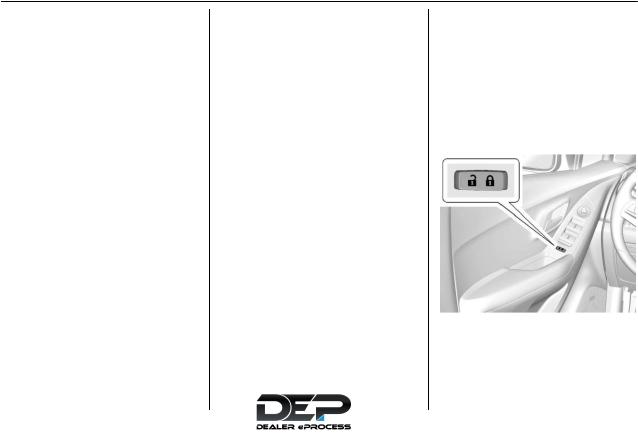
In Brief |
9 |
Lock and unlock feedback can be personalized. See Vehicle Personalization 0 134.
7 : If equipped, press and hold briefly to initiate vehicle locator. Press and hold for at least
three seconds to sound the panic alarm. Press again to cancel the panic alarm.
See Keys (Keyless Access) 0 27 or Keys (Key Access) 0 28 and Remote Keyless Entry (RKE) System Operation (Keyless Access) 0 30 or Remote Keyless Entry (RKE) System Operation (Key Access) 0 36.
Remote Vehicle Start
If equipped, the engine can be started from outside of the vehicle.
Starting the Vehicle
1.Press and release Q on the RKE transmitter.
2.Immediately press and hold / for at least four seconds or until the turn signal lamps flash.
Start the vehicle normally after entering.
When the vehicle starts, the parking lamps will turn on.
Remote start can be extended.
Canceling a Remote Start
To cancel a remote start, do one of the following:
.Press and hold / until the parking lamps turn off.
.Turn on the hazard warning flashers.
. Turn the vehicle on and then off.
See Remote Vehicle Start 0 39.
Door Locks
To lock or unlock the doors from the outside:
.Press K or Q on the Remote Keyless Entry (RKE) transmitter.
See Remote Keyless Entry (RKE) System Operation (Keyless Access) 0 30 or Remote Keyless Entry (RKE) System Operation (Key Access) 0 36.
.Use the key in the driver door.
To lock or unlock the doors from the inside:
Q : Press to lock the door.
K : Press to unlock the door.
See Power Door Locks 0 41.
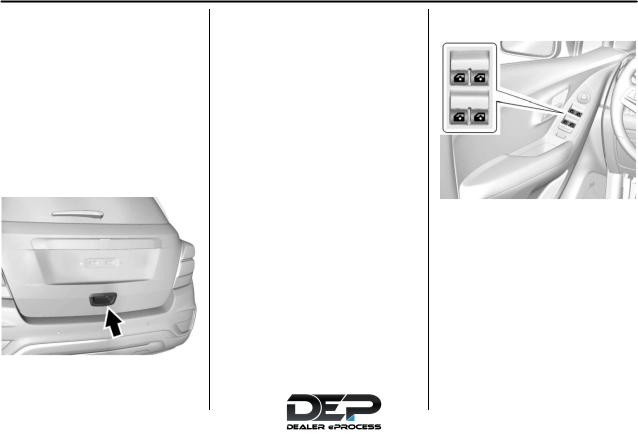
10 In Brief
Keyless Access
The RKE transmitter must be within 1 m (3 ft) of the door being opened.
Press the button on the door handle to open. See “Keyless Access Operation” under Remote Keyless Entry (RKE) System Operation (Keyless Access) 0 30 or Remote Keyless Entry (RKE) System Operation (Key Access) 0 36.
Liftgate
To open the liftgate, press K on the door lock switch or on the Remote Keyless Entry (RKE) transmitter to unlock all doors, then use the touch pad on the liftgate.
The liftgate may also be opened while the vehicle is locked by pressing the touch pad while the RKE transmitter is within 1 m (3 ft) of the rear of the vehicle.
Press Q on the door lock switch or on the RKE transmitter to lock the liftgate.
See Remote Keyless Entry (RKE) System Operation (Keyless Access) 0 30 or Remote Keyless Entry (RKE) System Operation (Key Access) 0 36.
See Liftgate 0 44.
Windows
Power windows work when the ignition is on, in ACC/ACCESSORY, or when Retained Accessory Power (RAP) is active. See Retained Accessory Power (RAP) 0 196.
Using the window switch, press to open or pull to close the window.
The windows may be temporarily disabled if they are used repeatedly within a short time.

In Brief |
11 |
Seat Adjustment |
Height Adjustment |
Power Seats |
Manual Seats
To adjust a manual seat:
1.Pull the handle at the front of the seat.
2.Slide the seat to the desired position and release the handle.
3.Try to move the seat back and forth to be sure it is locked in place.
If available, move the lever up or down to manually raise or lower the seat.
See Seat Adjustment 0 56.
To adjust the power driver seat, if available:
.Move the seat forward or rearward by sliding the control forward or rearward.
.Raise or lower the front part of the seat cushion by moving the front of the control up or down.
.Raise or lower the entire seat by moving the rear of the control up or down.
See Power Seat Adjustment 0 57.

12 In Brief
Reclining Seatbacks
Manual Seat Shown, Power Seat
Similar
To recline the seatback:
1.Lift the lever.
If necessary, move the seat belt out of the way to access the lever.
2.Move the seatback to the desired position, then release the lever to lock the seatback in place.
3.Push and pull on the seatback to make sure it is locked.
To return the seatback to an upright position:
1.Lift the lever fully without applying pressure to the seatback, and the seatback returns to the upright position.
2.Push and pull on the seatback to make sure it is locked.
See Reclining Seatbacks 0 58.
Second Row Seats
The rear seatbacks can be folded down to increase cargo space.
See Rear Seats 0 61.
Heated Seats
If available, the controls are on the climate control panel. To operate, the engine must be running.
Press M or L to heat the driver or passenger seat.
See Heated Front Seats 0 59.
Head Restraint
Adjustment
Do not drive until the head restraints for all occupants are installed and adjusted properly.

In Brief |
13 |
To achieve a comfortable seating position, change the seatback recline angle as little as necessary while keeping the seat and the head restraint height in the proper position.
See Head Restraints 0 55 and Seat
Adjustment 0 56.
Seat Belts
Refer to the following sections for important information on how to use seat belts properly:
.Seat Belts 0 65
.How to Wear Seat Belts Properly 0 66
.Lap-Shoulder Belt 0 68
.Lower Anchors and Tethers for Children (LATCH System) 0 92
Passenger Sensing
System
United States
Canada
The passenger sensing system turns off the front outboard passenger frontal airbag and knee airbag conditions. No
other airbag is affected by the passenger sensing system. See
Passenger Sensing System 0 79.
The passenger airbag status indicator will be visible on the instrument panel when the vehicle is started. See Passenger Airbag Status Indicator 0 117.
Mirror Adjustment
Exterior Mirrors
To adjust the mirrors:
1.Turn the selector switch to L (Left) or R (Right) to choose the driver or passenger mirror.

14 In Brief
2.Move the control to adjust the mirror.
3.Turn the selector switch to ( to deselect the mirror.
Interior Mirror
Adjustment
Adjust the rearview mirror to get a clear view of the area behind the vehicle.
Manual Rearview Mirror
If equipped, push the tab forward for daytime use and pull it for nighttime use to avoid the glare of headlamps from behind. See Manual Rearview Mirror 0 49.
Automatic Dimming Rearview
Mirror
If equipped, automatic dimming reduces the glare of headlamps from behind. The dimming feature comes on when the vehicle is started.
See Automatic Dimming Rearview
Mirror 0 49.
Steering Wheel
Adjustment
To adjust the steering wheel:
1.Pull the lever down.
2.Move the steering wheel up, down, forward, and backward.
3.Pull the lever up to lock the steering wheel in place.
Do not adjust the steering wheel while driving.
Interior Lighting
Front and Rear Dome Lamps
The front dome lamp controls are in the overhead console.
( : Press to turn the lamps off, even when a door is open.
H : When the button is returned to the middle position, the lamps turn on automatically when a door is opened.
' : Press to turn on the dome lamps.

In Brief |
15 |
Reading Lamps |
Exterior Lighting |
The rear dome lamp controls are in the headliner above the rear seats.
9 : Press to turn the lamps off, even when a door is open.
H : When the button is returned to the middle position, the lamps turn on automatically when a door is opened.
R : Press to turn on the dome lamps.
The front reading lamps are in the overhead console.
# or $ : Press to turn each lamp on or off.
For more information about interior lighting, see Instrument Panel Illumination Control 0 141 or Courtesy Lamps 0 142.
The exterior lamp control is on the instrument panel to the left of the steering column.
There are four positions:
O : Turns the exterior lamps off and deactivates the AUTO mode. Turn O again to reactivate the
AUTO mode.
In Canada, the headlamps will automatically reactivate when the vehicle is shifted out of P (Park).
AUTO : Turns the exterior lamps on and off automatically depending on outside lighting.
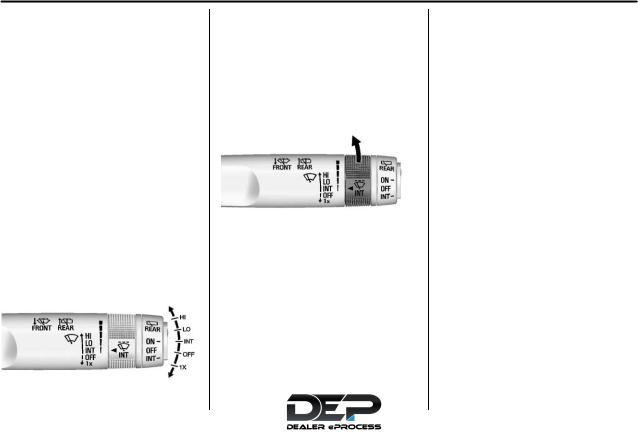
16 In Brief
; : Turns on the parking lamps including all lamps, except the headlamps.
5 : Turns on the headlamps together with the parking lamps and instrument panel lights. A warning chime sounds if the driver door is opened when the ignition is off and the headlamps are on.
# : If equipped with fog lamps, press to turn the lamps on or off.
See:
.Exterior Lamp Controls 0 138.
.Daytime Running Lamps (DRL) 0 139.
.Front Fog Lamps 0 141.
Windshield Wiper/Washer
The windshield wiper/washer lever is located on the right side of the steering column.
Move the lever to one of the following positions:
HI : Use for fast wipes.
LO : Use for slow wipes.
INT : Move the lever up to INT for intermittent wipes, then turn
the x INT band up for more frequent wipes or down for less frequent wipes.
OFF : Use to turn the wipers off.
1X : For a single wipe, briefly move the wiper lever down. For several wipes, hold the wiper lever down.
b : Pull the windshield wiper lever toward you
washer fluid wipers.
Rear Window Wiper/Washer
The rear wiper/washer controls are on the end of the windshield wiper lever.
ON : Press the upper portion of the button for continuous rear window wipes.
OFF : The rear wiper turns off when the button is returned to the middle position.
INT : Press the lower portion of the button to set a delay between wipes.
m= : Push the windshield wiper lever forward to spray washer fluid on the rear window. The lever returns to its starting position when released.
See Windshield Wiper/Washer
0 109 and Rear Window Wiper/
Washer 0 110.
Climate Controls
If equipped with these climate control systems, the heating, cooling, and ventilation can be controlled for the vehicle.
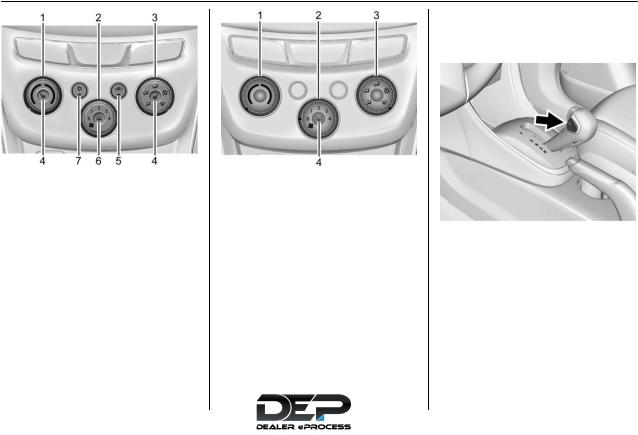
In Brief |
17 |
|
Climate Control System with |
|
Climate Control System with |
|
Heater and Air Conditioning |
|
Heater Only |
1. |
Temperature Control |
1. |
Temperature Control |
2. |
Fan Control |
2. |
Fan Control |
3. |
Air Delivery Mode Control |
3. |
Air Delivery Mode Control |
4. |
Driver and Passenger Heated |
4. |
Rear Window Defogger |
|
Seats |
See Climate Control Systems 0 171. |
|
|
|
||
5.Recirculation
6.Rear Window Defogger
7.Air Conditioning
Transmission
Driver Shift Control (DSC)
DSC allows you to shift an automatic transmission similar to a manual transmission. To use the DSC feature:
1.Move the shift lever from D (Drive) rearward to
M (Manual).
2.Press the + (plus) end of the button on the side of the shift lever to upshift, or press the − (minus) end of the button to downshift.
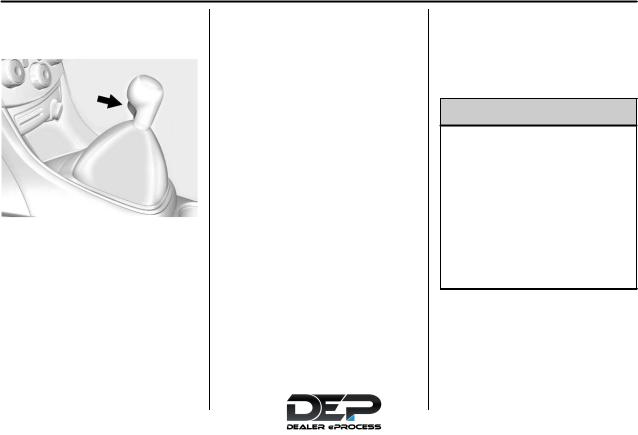
18 In Brief
See Manual Mode 0 202. |
Up-Shift Light |
Manual Transmission
To engage R (Reverse), with the vehicle stationary, pull up on the button on the shift lever and engage the gear. If the gear does not engage, set the lever in Neutral, release the clutch pedal, and apply it again; then repeat gear selection.
See Manual Transmission 0 204.
If the vehicle has a manual transmission, it may have an up-shift light that indicates when to shift to the next higher gear for the best fuel economy.
See Manual Transmission 0 204.
Vehicle Features
Infotainment System
Read the following pages to become familiar with the features.
{Warning
Taking your eyes off the road for too long or too often while using any infotainment feature can cause a crash. You or others could be injured or killed. Do not give extended attention to infotainment tasks while driving. Limit your glances at the vehicle displays and focus your attention on driving. Use voice commands whenever possible.
The infotainment system has built-in features intended to help avoid distraction by disabling some functions when driving. These functions may gray out when they are unavailable. Many infotainment

In Brief |
19 |
features are also available through the instrument cluster and steering wheel controls.
Before driving:
.Become familiar with the operation, center stack controls, and infotainment display controls.
.Set up the audio by presetting favorite stations, setting the tone, and adjusting the speakers.
.Set up phone numbers in advance so they can be called easily by pressing a single button or by using a single voice command if equipped with Bluetooth phone capability.
See Defensive Driving 0 178.
To play the infotainment system with the ignition off, see Retained Accessory Power (RAP) 0 196.
Radio(s)
O : Press to turn the system on. Press and hold to turn the system off. Turn to increase or decrease the volume.
g : Press and release to go to the previous station, channel, or track. Press and hold to fast seek the previous strongest station.
d : Press and release to go to the next station, channel, or track. Press and hold to fast seek the next strongest station.
Source : Touch to choose between available sources.
Menu : Touch to choose between available menus.
S or T : Touch to view saved favorite stations or channels.
See Overview 0 146.
Satellite Radio
If equipped, a SiriusXM satellite radio tuner and a valid SiriusXM
satellite radio subscription can |
|
receive |
. |
SiriusXM Satellite Radio
Service
SiriusXM is a satellite radio service based in the 48 contiguous United States and 10 Canadian provinces. SiriusXM satellite radio has a wide variety of programming and commercial-free music, coast to coast, and in digital-quality sound. A fee is required to receive the SiriusXM service.
Refer to:
.www.siriusxm.com or call 1-888-601-6296 (U.S.).
.www.siriusxm.ca or call 1-877-438-9677 (Canada).
See Satellite Radio 0 152.
Portable Audio Devices
This vehicle has a 3.5 mm (1/8 in) auxiliary input and two USB ports on the center stack. External devices such as iPods, MP3 players, and USB storage devices may be connected.
See Auxiliary Jack 0 156 and USB
Port 0 153.

20 In Brief
Bluetooth
The Bluetooth system allows users with a Bluetooth-enabled cell phone to make and receive hands-free calls using the vehicle audio system and controls.
The Bluetooth-enabled cell phone must be paired with the in-vehicle Bluetooth system before it can be used in the vehicle. Not all phones will support all functions.
See Bluetooth (Overview) 0 159 or Bluetooth (Pairing and Using the Phone) 0 160.
Steering Wheel Controls
Some audio steering wheel controls could differ depending on the vehicle's options. Some audio controls can be adjusted at the steering wheel.
b / g : Press to interact with the available Bluetooth or OnStar systems.
$ / i : Press to decline an incoming call, to end speech recognition, or to end a current call. Press to silence the vehicle
speakers while using the infotainment system. Press again to turn the sound on.
For vehicles with OnStar or Bluetooth systems, press to reject an incoming call or end a
current call.
_ SRC ^ : Press to select an audio source.
Toggle up or down to select the next or previous favorite radio station, CD/MP3 track, USB file, iPod/ iPhone song or Bluetooth music.
Toggle and hold up or down to fast forward or reverse the radio stations, CD/MP3 tracks, USB files, iPod/iPhone songs, or Bluetooth music.
+ x − : Press + or − to increase or decrease the volume.
See Steering Wheel Controls 0 108.

In Brief |
21 |
Cruise Control
If equipped with the cruise control system:
o : Press to turn the cruise control system on and off. A white indicator comes on in the instrument cluster when cruise is turned on.
RES/+ : If there is a set speed in memory, move the thumbwheel up briefly to resume to that speed or hold upward to accelerate. If cruise control is already active, use to increase vehicle speed.
SET/− : Move the thumbwheel down briefly to set the speed and activate cruise control. If cruise control is already active, use to decrease speed.
n : Press to disengage cruise control without erasing the set speed from memory.
See Cruise Control 0 210.
Driver Information
Center (DIC)
DIC Operation and Displays
The DIC display is in the instrument cluster. It shows the status of many vehicle systems.
On some models, the trip odometer reset stem is used to operate the DIC. On other models, the controls for the DIC are on the turn signal lever.
DIC Buttons
1.SET/CLR: Press to set or clear the menu item displayed.
2.w / x : Turn to scroll through the menus.
3.MENU: Press to display the DIC menus. This button is also used to return to or exit the last screen displayed on the DIC.
See Driver Information Center (DIC) 0 127.
Forward Collision Alert
(FCA) System
If equipped, FCA may help avoid or reduce the harm caused by front-end crashes. FCA provides a
green indicator, V, when a vehicle is detected ahead. This indicator displays amber if you follow a

22 In Brief
vehicle much too closely. When approaching a vehicle ahead too quickly, FCA provides a red flashing alert on the windshield and rapidly beeps.
See Forward Collision Alert (FCA)
System 0 217.
Lane Departure
Warning (LDW)
If equipped, LDW may help avoid unintentional lane departures at speeds of 56 km/h (35 mph) or greater. LDW uses a camera sensor to detect the lane markings. The
LDW light, @, is green if a lane marking is detected. If the vehicle departs the lane without using a turn signal in that direction, the light will change to amber and flash. In addition, beeps will sound.
See Lane Departure Warning (LDW) 0 221.
Rear Vision
Camera (RVC)
If equipped, RVC displays a view of the area behind the vehicle, on the infotainment display, when the vehicle is shifted into R (Reverse).
See Rear Vision Camera (RVC) 0 214.
Rear Cross Traffic Alert
(RCTA) System
If equipped, the RCTA system uses a triangle with an arrow on the infotainment display to warn of traffic behind your vehicle that may cross your vehicle's path while in R (Reverse). In addition, beeps will sound.
See “Rear Cross Traffic Alert (RCTA)” under Rear Vision Camera (RVC) 0 214.
Park Assist
If equipped, Rear Park Assist (RPA) uses sensors on the rear bumper to assist with parking and avoiding objects while in R (Reverse).
It operates at speeds less than 8 km/h (5 mph) and uses audible beeps to provide distance and system information.
Keep the sensors on the vehicle's rear bumper clean to ensure proper operation.
See Park Assist 0 216.
Power Outlets
Power Outlet 110/120 Volt
Alternating Current
If equipped, this power outlet is on the rear of the center console. It can be used to plug in electrical equipment that uses a maximum limit of 150 watts.
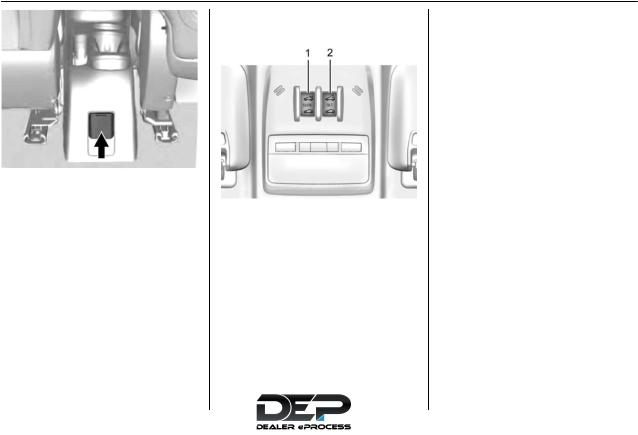
In Brief |
23 |
An indicator light on the outlet turns on to show it is in use. The light comes on when the ignition is on and equipment requiring less than 150 watts is plugged into the outlet, and no system fault is detected.
The indicator light does not come on when the ignition is off or if the equipment is not fully seated into the outlet.
See Power Outlets 0 111.
Sunroof
If equipped, the sunroof only operates when the ignition is on or when Retained Accessory Power (RAP) is active. See Retained Accessory Power (RAP) 0 196.
Slide Switch
Express-Open/Express-Close :
Press and release D (1) at the second detent to express-open the sunroof. Press and release g(1) at the second detent to
express-close the sunroof. Press the switch again to stop the movement.
Open/Close (Manual Mode) :
Press and hold D (1) at the first detent to open the sunroof. Press and hold g(1) at the first detent to close the sunroof. Release the switch to stop the movement.
Tilt Switch
Vent : Press and hold E (2) to vent
the sunroof. Press and hold g(2) to close the sunroof vent.
The sunshade opens automatically with the sunroof, but must be manually closed.
The sunroof will not operate if the vehicle has an electrical failure.
The sunroof has an automatic reversal system feature. See
Sunroof 0 52.

24 In Brief
Performance and
Maintenance
Traction Control/
Electronic Stability
Control
If equipped, the Traction Control System (TCS) limits wheel spin. The system is on when the vehicle is started.
If equipped, the StabiliTrak/ Electronic Stability Control (ESC) system assists with directional control of the vehicle in difficult driving conditions. The system is on when the vehicle is started.
.To turn off TCS, press and
release g on the center stack. i illuminates in the instrument cluster and the appropriate DIC message may display.
.Press and release g again to turn TCS back on.
.To turn off both TCS and StabiliTrak/ESC, press and hold g until g and i illuminate in the instrument cluster and the appropriate DIC message may display.
.Press g again to turn on both systems.
See Traction Control/Electronic
Stability Control 0 208.
Tire Pressure Monitor
This vehicle may have a Tire Pressure Monitor System (TPMS).
The low tire pressure warning light alerts to a significant loss in pressure of one of the vehicle's tires. If the warning light comes on, stop as soon as possible and inflate the tires to
pressure
Loading Information label. See
Vehicle Load Limits 0 184. The warning light will remain on until the tire pressure is corrected.
The low tire pressure warning light may come on in cool weather when the vehicle is first started, and then turn off as the vehicle is driven. This may be an early indicator that the tire pressures are getting low and the tires need to be inflated to the proper pressure.
The TPMS does not replace normal monthly tire maintenance. Maintain the correct tire pressures.
See Tire Pressure Monitor System 0 281.
Fuel

In Brief |
25 |
Regular Unleaded Fuel
Use only Regular 87 octane — (R+M)/2 — or higher unleaded gasoline in your vehicle.
TOP TIER Detergent Gasoline is recommended. Do not use gasoline with an octane rating lower as it will result in reduced performance and lower fuel economy. See
Recommended Fuel 0 223.
E85 or FlexFuel
No E85 or FlexFuel
Gasoline-ethanol fuel blends greater than E15 (15% ethanol by volume), such as E85, cannot be used in this vehicle.
Engine Oil Life System
The engine oil life system calculates engine oil life based on vehicle use and displays a message on the Driver Information Center (DIC) when it is necessary to change the engine oil and filter.
The oil life system should be reset to 100% only following an oil change.
Resetting the Oil Life System
Reset the system whenever the engine oil is changed so that the system can calculate the next engine oil change. It will not reset itself. To reset the system:
Base Level Cluster
1.Press the MENU button to show Remaining Oil Life on the display. This display shows an estimate of the oil’s remaining useful life. If 99% is displayed, that means that 99% of the current oil life remains.
2.To reset the engine oil life system, press SET/CLR while the oil life display is active. After a few seconds, the oil life will be reset to 100%. Be careful not to reset the oil life display accidentally at any time other than after the oil is changed. It cannot be reset accurately.
If the : % CHANGE message in the DIC comes back on when the vehicle is started, the engine oil life system has not reset. Repeat the procedure.
Uplevel Cluster
1.Turn the ignition on without starting the engine.
2.Press the DIC MENU button on the turn signal lever to enter the Vehicle Information Menu. Use the thumbwheel to scroll through the menu items until you reach REMAINING
OIL LIFE.
3.Press SET/CLR to reset the oil life at 100%.

26 In Brief
4. Turn the ignition off.
See Engine Oil Life System 0 240.
Driving for Better Fuel Economy
Driving habits can affect fuel mileage. Here are some driving tips to get the best fuel economy possible:
.Set the climate controls to the desired temperature after the engine is started, or turn them off when not required.
.Avoid fast starts and accelerate smoothly.
.Brake gradually and avoid abrupt stops.
.Avoid idling the engine for long periods of time.
.When road and weather conditions are appropriate, use cruise control.
.Always follow posted speed limits or drive more slowly when conditions require.
.Keep vehicle tires properly inflated.
.Combine several trips into a single trip.
.Replace the vehicle's tires with the same TPC Spec number molded into the tire's sidewall near the size.
.Follow recommended scheduled maintenance.
Roadside Assistance
Program
U.S.: 1-800-243-8872
TTY Users (U.S. Only): 1-888-889-2438
Canada: 1-800-268-6800
New Chevrolet owners are automatically enrolled in the Roadside Assistance Program.
See Roadside Assistance Program 0 338.

Keys, Doors, and Windows 27
Keys, Doors, and
Windows
Keys and Locks
Keys (Keyless Access) . . . . . . . . 27
Keys (Key Access) . . . . . . . . . . . . 28
Remote Keyless Entry (RKE)
System . . . . . . . . . . . . . . . . . . . . . . . 30
Remote Keyless Entry (RKE)
System Operation (Keyless
Access) . . . . . . . . . . . . . . . . . . . . . . 30
Remote Keyless Entry (RKE)
System Operation (Key
Access) . . . . . . . . . . . . . . . . . . . . . . 36
Remote Vehicle Start . . . . . . . . . . 39
Door Locks . . . . . . . . . . . . . . . . . . . . 40
Power Door Locks . . . . . . . . . . . . . 41
Delayed Locking . . . . . . . . . . . . . . . 41
Automatic Door Locks . . . . . . . . . 42
Lockout Protection . . . . . . . . . . . . . 42
Safety Locks . . . . . . . . . . . . . . . . . . . 43
Doors
Liftgate . . . . . . . . . . . . . . . . . . . . . . . . 44
Vehicle Security
Immobilizer Operation (Keyless
Access) . . . . . . . . . . . . . . . . . . . . . . 46
Immobilizer Operation (Key
Access) . . . . . . . . . . . . . . . . . . . . . . 47
Exterior Mirrors
Convex Mirrors . . . . . . . . . . . . . . . . 48
Power Mirrors . . . . . . . . . . . . . . . . . . 48
Folding Mirrors . . . . . . . . . . . . . . . . . 49
Heated Mirrors . . . . . . . . . . . . . . . . . 49
Interior Mirrors
Interior Rearview Mirrors . . . . . . . 49
Manual Rearview Mirror . . . . . . . . 49
Automatic Dimming Rearview
Mirror . . . . . . . . . . . . . . . . . . . . . . . . . 49
Windows
Windows . . . . . . . . . . . . . . . . . . . . . . . 50
Power Windows . . . . . . . . . . . . . . . 50
Sun Visors . . . . . . . . . . . . . . . . . . . . . 52
Roof
Sunroof . . . . . . . . . . . . . . . . . . . . . . . . 52
Keys and Locks
Keys (Keyless Access)
{Warning
Leaving children in a vehicle with a Remote Keyless Entry (RKE) transmitter is dangerous and children or others could be seriously injured or killed. They could operate the power windows or other controls or make the vehicle move. The windows will function with the RKE transmitter in the vehicle, and children or others could be caught in the path of a closing window. Do not leave children in a vehicle with an RKE transmitter.
Vehicle Security . . . . . . . . . . . . . . . . 45
Vehicle Alarm System . . . . . . . . . 45
Immobilizer . . . . . . . . . . . . . . . . . . . . 46

28 Keys, Doors, and Windows
Press the key release button on the side of the RKE transmitter to release the key. Never pull out the key without pressing the button.
The key code is stamped on the key number plate and can be used to make new keys at any dealer. Store this information in a safe place outside the vehicle.
See your dealer if a new key is needed.
If locked out of the vehicle, contact Roadside Assistance. See Roadside Assistance Program 0 338.
With an active OnStar or connected service plan, an OnStar Advisor may remotely unlock the vehicle. See OnStar Overview 0 348.
Keys (Key Access)
{Warning
Warning (Continued)
seriously injured or killed. They could operate the power windows or other controls or make the vehicle move. The windows will function with the keys in the ignition, and children or others could be caught in the path of a closing window. Do not leave children in a vehicle with the ignition key.
The key that is part of the Remote Keyless Entry (RKE) transmitter can be used for all locks.
Leaving children in a vehicle with the ignition key is dangerous and children or others could be

Keys, Doors, and Windows 29
{Warning
If the key is unintentionally rotated while the vehicle is running, the ignition could be moved out of the RUN position. This could be caused by heavy items hanging from the key ring, or by large or long items attached to the key ring that could be contacted by the driver or steering wheel. If the ignition moves out of the RUN position, the engine will shut off, braking and steering power assist may be impacted, and airbags may not deploy. To reduce the risk of unintentional rotation of the ignition key, do not change the way the ignition key and Remote Keyless Entry (RKE) transmitter, if equipped, are connected to the provided key rings.
The ignition key and key rings, and RKE transmitter, if equipped, are designed to work together as a system to reduce the risk of unintentionally moving the key out of the RUN position. The ignition key has a small hole to allow attachment of the provided key ring. It is important that any replacement ignition keys have a small hole. See your dealer if a replacement key is required.
The combination and size of the rings that came with your keys were specifically selected for your vehicle. The rings are connected to the chain to
reduce the risk of unintentionally moving the key out of the RUN position. Do not add any additional items to the ring attached to the ignition key. Attach additional items only to the second ring, and limit added items to a few essential keys or small, light items no larger than an RKE transmitter.
Interference from radio-frequency identification (RFID) tags may prevent the key from starting the vehicle. Keep RFID tags away from the key when starting the vehicle.
